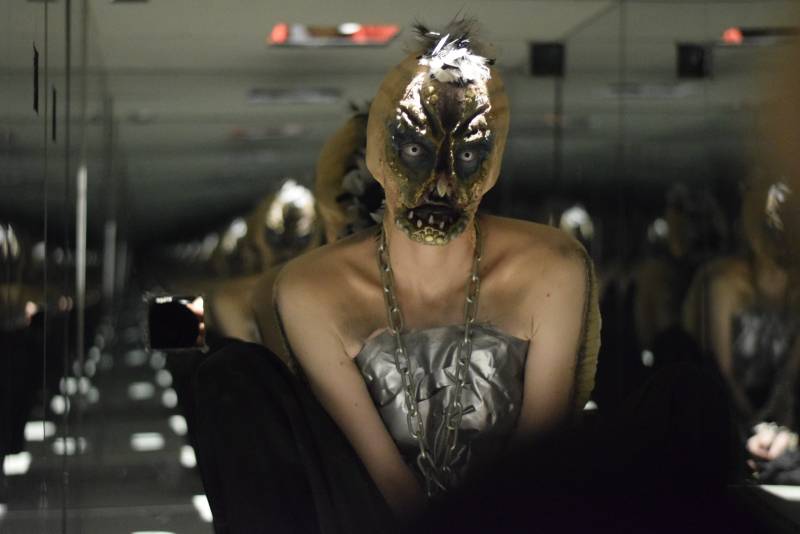
To systematize means to make a system predictable by making a formula. All things, properties and relations that strike us as something independent are essentially parts of some system, which in its turn is part of an even bigger system, and so on ad infinitum. For example, the whole of world civilization is no more than a large and extremely complex self-developing system, which comprises other systems of varying degrees of complexity.
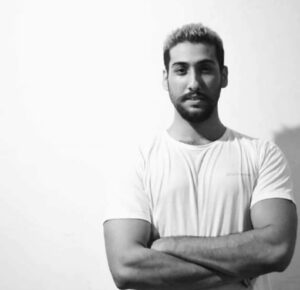
Every system is something whole. So anything that corresponds to the demands of unity and stability—an atom, a molecule, a crystal, the solar system, the organism, society, a work of art, a theory—may be regarded as a system.
Every system forms a whole, but not every whole is a system.
While, structure comes from the Latin word "Structura" which means to fit together or to build. Therefore, structure is the manner in which constituents of a system are arranged to form a unified whole i.e. is the connection between the elements of a whole. It has its own internal dialectic. Wholeness must be composed in a certain way, its parts are always related to the whole. Structures thus tend to be “external” as opposed to systems that are “internal”. Structure implies not only the position of its elements in space but also their movement in time, their sequence and rhythm, the law of mutation of a process. So structure is actually the law or set of laws that determine a system's composition and functioning, its properties and stability.
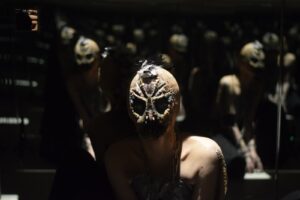
Art they say is the outcome of imagination. To the contrary it is a consequence of a system. Systems operate in similar fashion as concepts in other domains, for instance “Politics, Race, Gender, Class”. Differences or loopholes present in a system are the very products of the system or “System constructs”. This exhibit aims to investigate the arbitrary, assertive and oppressive nature of systems in relation to the lived experiences of humans functioning within those systems.
The inaugural exhibition curated by Talal Faisal Ismaili featured four artists - Alina Tauseef, Gillian Rhodes, Idrees Hanif and Sundas Rafi - at the University of Lahore, the School of Creative Arts.
Emanating from personal relationships and spontaneous encounters, Idrees Hanif’s outcomes take their final form as object and images that have accrued shifting layers of meaning. He weaves together personal histories with macro narratives and collective experiences to explore broader social or political themes that investigate issues of authorship, authority and questions of identity and belonging. He works in Sculpture/Installation, photography, video, performance and sound.
“I study objects as an anatomy of the everyday. My process of scrutiny of the everyday within intimate urban geographies enables me to examine the complexities of the mundane and the dialectic relationship we share. It is dynamic, transformative, a process of learning and unlearning."
Hanif is particularly interested in discrepancies between myth and reality, between the past and the present, between the malleable identities and imposed histories. His practice is a manifestation of his Dialectical philosophy: the ability to view the everyday from multiple perspectives to arrive at the most economical and reasonable reconciliation of seemingly contradictory information and postures.
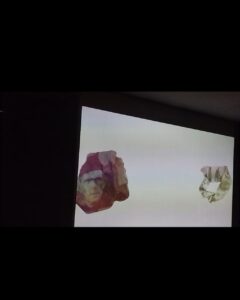
Title : Letters to the Land
The work is an extension of the artist’s scrutiny of the everyday, this time with focus on discarded entities: fragments of objects and/or outer shells of consumed commodities.
He observed his 8 month old son always on the lookout for miniscule objects or fragments of objects which sparked the artist’s interest in the Redundant/Marginalized aspect of the everyday. He thus began photographing his encounter with these micro entities lying on the soil, on Sunday morning walks to the park with his toddler.
Idrees interprets these as urban archives or fragments of time: records of the land and its inhabitants. He draws a parallel between these Urban Archives and History as a discipline, both amoebic in nature as opposed to dogmatic thereby allowing for interpretations and reinterpretations in varying contexts.
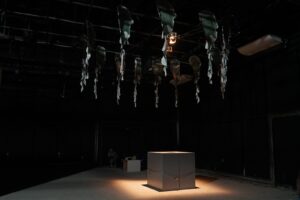
GILLIAN RHODES
Trained as a classical dancer, U.S. born Gillian Rhodes’ multifaceted practice is rooted in movement and body language.
“I am a performer and storyteller. I use a variety of mediums to tell stories, from the stage to the page, from live to recorded.. My work often explores themes of gender, identity, and belonging. Characters and their journeys are important, and recently I have developed 4 artistic alter egos (ala Ziggy Stardust) to address my concerns.”
Title : Breaker Maker Dreamtaker
Breaker Maker Dreamtaker is not a statement, or an ideology. It is merely a question, a mirror, a half open door that invites the audience to peer inside (literally) and decide for themselves what they see. It reflects on freedom and free will within and without the systems, and the (un)reality of the structures that make it up.
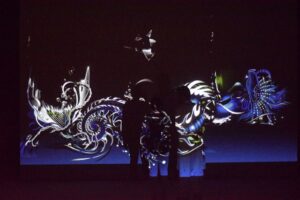
ALINA TAUSEEF
Lahore based Visual artist Alina Tauseef’s digital practice employs illustration and animation to exemplify a documentation of the self, touching on themes of individuality, consciousness, dreams, mysticism and the unknown.
“Every frame of my animation constructs the narrative within which I reside,
Just like all aspects of an individual’s life shape the context within which that person lives”
Title : The ocean of the Self
Deep inside the Ocean, lies mysticism. Rich in knowledge and steeped in wisdom, it is past, present and future all at once, beginning and end, life after death and death after life. Just as the depths of the Universe remain a mystery, so too does the Great Unknown, residing within each of us, elude the realms of physicality. What were you before you were born, where were you ?
SUNDAS RAFI
I have played with non-physical absences while creating physical existences out of triangle forms, indicative of the construction of my discursive memory and thoughts. The non-physicality of the gaps is the translation of a void that erupts out of the conflict of the conscious and the unconscious, dreams and reality, the paradox of life.
Friedrich Nietzsche describes it simply - “There are no beautiful surfaces without terrible depth”
The emergence of conscious thoughts highlights the vital relation between Content and Context that are intrinsic to the very process of seeing: Seeing within and Seeing around.
Title : The gap in between

Every system is something whole. So anything that corresponds to the demands of unity and stability—an atom, a molecule, a crystal, the solar system, the organism, society, a work of art, a theory—may be regarded as a system.
Every system forms a whole, but not every whole is a system.
While, structure comes from the Latin word "Structura" which means to fit together or to build. Therefore, structure is the manner in which constituents of a system are arranged to form a unified whole i.e. is the connection between the elements of a whole. It has its own internal dialectic. Wholeness must be composed in a certain way, its parts are always related to the whole. Structures thus tend to be “external” as opposed to systems that are “internal”. Structure implies not only the position of its elements in space but also their movement in time, their sequence and rhythm, the law of mutation of a process. So structure is actually the law or set of laws that determine a system's composition and functioning, its properties and stability.

Art they say is the outcome of imagination. To the contrary it is a consequence of a system. Systems operate in similar fashion as concepts in other domains, for instance “Politics, Race, Gender, Class”. Differences or loopholes present in a system are the very products of the system or “System constructs”. This exhibit aims to investigate the arbitrary, assertive and oppressive nature of systems in relation to the lived experiences of humans functioning within those systems.
The inaugural exhibition curated by Talal Faisal Ismaili featured four artists - Alina Tauseef, Gillian Rhodes, Idrees Hanif and Sundas Rafi - at the University of Lahore, the School of Creative Arts.
IDREES HANIF
Emanating from personal relationships and spontaneous encounters, Idrees Hanif’s outcomes take their final form as object and images that have accrued shifting layers of meaning. He weaves together personal histories with macro narratives and collective experiences to explore broader social or political themes that investigate issues of authorship, authority and questions of identity and belonging. He works in Sculpture/Installation, photography, video, performance and sound.
“I study objects as an anatomy of the everyday. My process of scrutiny of the everyday within intimate urban geographies enables me to examine the complexities of the mundane and the dialectic relationship we share. It is dynamic, transformative, a process of learning and unlearning."
Hanif is particularly interested in discrepancies between myth and reality, between the past and the present, between the malleable identities and imposed histories. His practice is a manifestation of his Dialectical philosophy: the ability to view the everyday from multiple perspectives to arrive at the most economical and reasonable reconciliation of seemingly contradictory information and postures.

Title : Letters to the Land
The work is an extension of the artist’s scrutiny of the everyday, this time with focus on discarded entities: fragments of objects and/or outer shells of consumed commodities.
He observed his 8 month old son always on the lookout for miniscule objects or fragments of objects which sparked the artist’s interest in the Redundant/Marginalized aspect of the everyday. He thus began photographing his encounter with these micro entities lying on the soil, on Sunday morning walks to the park with his toddler.
Idrees interprets these as urban archives or fragments of time: records of the land and its inhabitants. He draws a parallel between these Urban Archives and History as a discipline, both amoebic in nature as opposed to dogmatic thereby allowing for interpretations and reinterpretations in varying contexts.

GILLIAN RHODES
Trained as a classical dancer, U.S. born Gillian Rhodes’ multifaceted practice is rooted in movement and body language.
“I am a performer and storyteller. I use a variety of mediums to tell stories, from the stage to the page, from live to recorded.. My work often explores themes of gender, identity, and belonging. Characters and their journeys are important, and recently I have developed 4 artistic alter egos (ala Ziggy Stardust) to address my concerns.”
Title : Breaker Maker Dreamtaker
Breaker Maker Dreamtaker is not a statement, or an ideology. It is merely a question, a mirror, a half open door that invites the audience to peer inside (literally) and decide for themselves what they see. It reflects on freedom and free will within and without the systems, and the (un)reality of the structures that make it up.

ALINA TAUSEEF
Lahore based Visual artist Alina Tauseef’s digital practice employs illustration and animation to exemplify a documentation of the self, touching on themes of individuality, consciousness, dreams, mysticism and the unknown.
“Every frame of my animation constructs the narrative within which I reside,
Just like all aspects of an individual’s life shape the context within which that person lives”
Title : The ocean of the Self
Deep inside the Ocean, lies mysticism. Rich in knowledge and steeped in wisdom, it is past, present and future all at once, beginning and end, life after death and death after life. Just as the depths of the Universe remain a mystery, so too does the Great Unknown, residing within each of us, elude the realms of physicality. What were you before you were born, where were you ?
SUNDAS RAFI
I have played with non-physical absences while creating physical existences out of triangle forms, indicative of the construction of my discursive memory and thoughts. The non-physicality of the gaps is the translation of a void that erupts out of the conflict of the conscious and the unconscious, dreams and reality, the paradox of life.
Friedrich Nietzsche describes it simply - “There are no beautiful surfaces without terrible depth”
The emergence of conscious thoughts highlights the vital relation between Content and Context that are intrinsic to the very process of seeing: Seeing within and Seeing around.
Title : The gap in between

